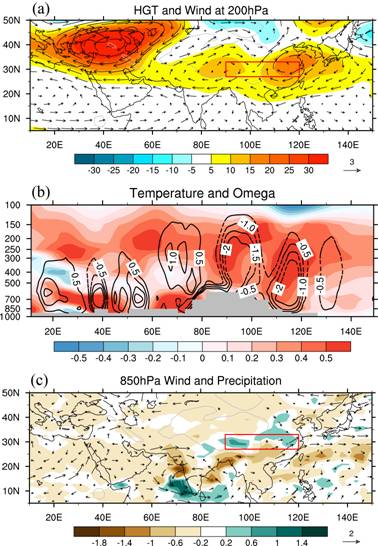Since the work by TAO Shiyan and ZHU Fukang's in 1964, variation of South Asian High (SAH) and its relationship with East Asian summer precipitation have long been an attractive topic. It has been widely accepted that SAH is a cause of summer rainfall variability in the East Asia through more than 5 decades. This wisdom is also where the China’s operational prediction of the summer precipitation built on.
However, this one-way cause-effect relationship might be misleading at certain time scales. It is misleading because precipitation itself, through the release of latent heating, can be a direct energy source to drive the large-scale circulation. This feedback of rainfall to large-scale circulation results from the dynamic constraint placed by potential vorticity (PV) balance.
From the perspective of Potential Vorticity balance, a recent work by Drs. ZHANG Pengfei (now at Purdue University), LIU Yimin, and HE Bian, from Institute of Atmospheric Physics, Chinese Academy of Science, revisited the cause-effect loop between SAH and East Asian summer monsoon (EASM) at an interannual scale.

Figure 1 Responses of SAH to EASM condensation heating in AGCM experiment: (a) 200 hPa geopotential height (shaded, units: gpm) and wind (vector, units: m s-1); (b) 28 o-32oN averaged height-longitude cross-section of vertical velocity (contour, units: 0.01 Pa s-1) and temperature (shaded, units: K) along 30oN; (c) 850 hPa wind (vector, units: m s-1) and precipitation (shaded, units: mm day-1). The responses are the differences between sensitivity experiment and control run. Red box shows the T-Y region where the condensational heating is prescribed in. Gray lines in (a) and (c) delineate the topographic boundary of 1500m. Gray shaded in (b) denotes the topography. (Figure plotted by IAP)
By conducting dynamical diagnosis and the numerical experiments, they show that the excessive EASM heating excites a local anticyclone in the upper troposphere and warms the upper troposphere, leading to the eastward extension of the SAH’s eastern edge and reinforcing geopotential height anomalies over East Asia. Furthermore, the monsoonal heating excites a westward-propagating Rossby wave that increases the upper-tropospheric geopotential height and warms the upper troposphere over the Middle East.
Their new study suggests that monsoonal heating released along the east Tibetan Plateau-Yangtze River Valley can influence the SAH intensity by exciting a westward propagating Rossby waves as a result of PV balance. The mechanism is corroborated by simulations using both an idealized model and AGCM. The new study therefore revises the existing SAH-EASM paradigm.
Reference:
Pengfei Zhang, Yimin Liu, and Bian He, 2016: Impact of East Asian Summer Monsoon Heating on the Interannual Variation of the South Asian High. J. Climate, 29, 159–173.
Contact: HE Bian, heb@lasg.iap.ac.cn
